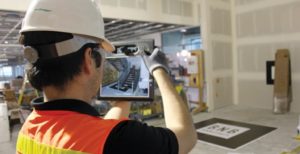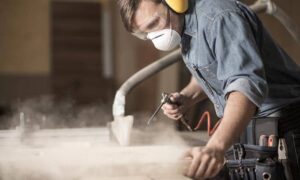
Navigating the new normal: A guide for building professionals in a post-pandemic landscape
![]()
![]() The impact of the novel coronavirus (COVID-19) is both far-reaching and deep, especially for the building industry, which has been permanently changed. As building professionals across the country have stepped up in this new landscape, they, like many other industries, are finding it necessary to reimagine their workflow by expanding resources and capabilities with new technologies.
The impact of the novel coronavirus (COVID-19) is both far-reaching and deep, especially for the building industry, which has been permanently changed. As building professionals across the country have stepped up in this new landscape, they, like many other industries, are finding it necessary to reimagine their workflow by expanding resources and capabilities with new technologies.
According to survey results from the International Code Council, while the majority of code departments surveyed (93 percent) were still performing inspections — either remotely or in-person — six in 10 respondents did not have the capability to remotely carry out critical aspects of their work. Since being declared an essential industry by the Department of Homeland Security, code officials and those in related fields have needed to quickly adapt to a “new normal” in order to fulfill responsibilities, such as ensuring that temporary structures like field hospitals are safe for use. Without additional resources from the government, the safety of code officials, inspectors and the general public are put at risk.
Even more, the potential for a larger disruption in work, from unwell workers or stalled/delayed permitting and inspections, is a threat to the overall economy. However, this does not mean the industry has been sitting idle waiting on additional resources. Instead, building safety professionals have increased interdisciplinary collaboration to adapt and reinvent the industry through tips, best practices and key learnings for commercial and residential buildings.
Minimizing risk — new safety precautions
 The landscape has changed drastically causing many in the building industry to enforce rules and guidelines that were unthought-of six months ago. Along with stringently adhering to the guidelines for social distancing provided by the U.S. Centers for Disease Control and Prevention, various building safety departments have taken it a step further to mitigate against the possibility of an outbreak. This is critically important as there are still many functions and responsibilities from inspections to construction that require code professionals to be on the jobsite.
The landscape has changed drastically causing many in the building industry to enforce rules and guidelines that were unthought-of six months ago. Along with stringently adhering to the guidelines for social distancing provided by the U.S. Centers for Disease Control and Prevention, various building safety departments have taken it a step further to mitigate against the possibility of an outbreak. This is critically important as there are still many functions and responsibilities from inspections to construction that require code professionals to be on the jobsite.
For code officials, it has become common practice for all workers to vacate an area while the on-site inspection is taking place to minimize exposure. This has become necessary because even though virtual inspections are technically possible, the Code Council found that 61 percent of departments did not have the capabilities to perform this task. For construction practices, new methods include creating teams of workers that only interact with the same people on any number of projects. This way, if one person were to contract the virus, the number of people exposed would be minimized.
Safety starts at home
Navigating through the state of current affairs, the most critical lesson society has been relearning is the invaluable role our homes play in keeping us safe. Beyond being a simple place of residence, our houses and apartments are now also our gyms, education centers and entertainment venues. It is important for homeowners and residential managers to be implementing proper measures to maximize safety during these times and beyond.
 For multi-family housing units where residents share many of the same facilities, building managers should evaluate common areas such as game rooms, public pools, gyms, laundry facilities and more to determine appropriate measures. For an area such as a public pool it may make more sense to temporarily close the facility, while a game room may be opened with limited capacity and stringent cleaning protocols. However, in order for any social distancing and cleaning measures to be truly effective, building managers will need to educate their tenants on proper procedures, from elevator usage to proper handling of their packages and deliveries. Proper signage is invaluable in this process.
For multi-family housing units where residents share many of the same facilities, building managers should evaluate common areas such as game rooms, public pools, gyms, laundry facilities and more to determine appropriate measures. For an area such as a public pool it may make more sense to temporarily close the facility, while a game room may be opened with limited capacity and stringent cleaning protocols. However, in order for any social distancing and cleaning measures to be truly effective, building managers will need to educate their tenants on proper procedures, from elevator usage to proper handling of their packages and deliveries. Proper signage is invaluable in this process.
On the other hand, procedures and strategies will differ for single-family housing, because it is less about public health measures and more about the utilization of space and desired amenities moving forward. For example, with the majority of the workforce currently working remotely, it is likely that there will be an increased interest in a dedicated home office space. Other considerations may include creating designated spaces for deliveries or areas for handling “outdoor” clothes and disposing of gloves and masks.
Along with space utilization, many homeowners are also looking at renovations and repairs that have long been neglected. Stay-at-home orders left many with more time on their hands, and there has been an increase in both big and small renovation projects. However, if a homeowner is engaging in a project that will require a contractor, they must evaluate when the right time is to start and decide what conditions and protocols contractors need to follow while inside their home. Once decided, this may even be the perfect time to have a heating, ventilation, and air conditioning tune-up and check or replace the filters to improve airflow, which has been found to have a significant impact on the spread of COVID-19.
Prepping buildings for safe re-occupancy
As local and state governments are beginning a tiered reopening of their economies and businesses resume activities in office, one important but often overlooked safety precaution will be preparing a stagnant office building for occupancy. Without proper preparation and maintenance, the building can pose a danger to incoming occupants, whether from a stagnant heating, ventilation and air conditioning or plumbing system to a powerless carbon-monoxide detector.
Given the wide range of aspects to consider when reopening an office, the Code Council has created an extensive list of tips and considerations to keep in mind before resuming normal activity. These tips cover topics such as reviewing building plans, fire and life safety considerations, restarting the plumbing and mechanical systems, and more. Priority considerations include:
- If a building’s water distribution system has been shut down or seen reduced flow, the pipe system must be flushed with clean, potable water to remove any possible bacteria;
- Address any temporary changes needed to building access and exit patterns to accommodate temporary reopening protocols such as employee health screenings, disposal of personal protective equipment, or any areas specifically designated for decontamination; and
- Close common areas where personnel are likely to congregate and interact or enforce strict physical distancing protocols.
Designing for the future
Before the economy can truly restart and businesses begin to successfully reopen, employees and consumers must feel comfortable venturing out into the public again. Instilling this sense of safety and security begins with upgrading buildings with modernized building codes that address public health concerns and social distancing guidelines, including physical barriers between cashiers and customers and six feet of distance between colleagues in the office.
 While some wish for a quick update that easily addresses these concerns, updating pre-existing building codes requires a thorough process to ensure the codes are safe and effective. In fact, the International Codes (I-Codes) developed by the Code Council are created using a rigorous process that draws upon the expertise of hundreds of plumbing, mechanical, building and safety experts.
While some wish for a quick update that easily addresses these concerns, updating pre-existing building codes requires a thorough process to ensure the codes are safe and effective. In fact, the International Codes (I-Codes) developed by the Code Council are created using a rigorous process that draws upon the expertise of hundreds of plumbing, mechanical, building and safety experts.
Understanding the current urgency, the Code Council is gathering the brightest minds across the building industry for a taskforce whose focus will be on addressing COVID-19 concerns and creating tips and best practices for preparing buildings for re-occupancy. The knowledge stemming from the taskforce will also be considered for the latest edition of the I-Codes.
Although no one can predict with certainty what will happen long-term, the building industry has been presented with a great opportunity to reinvent itself. Coming out of this pandemic, not only will our industry be stronger than ever but we’ll also see a higher emphasis on safety and protocols. After all, safety starts at home and continues on at the jobsite or office.








